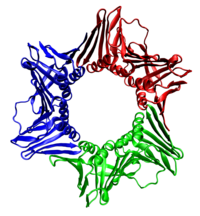
Photo from wikipedia
Smc5/6, like cohesin and condensin, is a structural maintenance of chromosomes complex crucial for genome stability. Unlike cohesin and condensin, Smc5/6 carries an essential Nse2 subunit with SUMO E3 ligase… Click to show full abstract
Smc5/6, like cohesin and condensin, is a structural maintenance of chromosomes complex crucial for genome stability. Unlike cohesin and condensin, Smc5/6 carries an essential Nse2 subunit with SUMO E3 ligase activity. ABSTRACT Smc5/6, like cohesin and condensin, is a structural maintenance of chromosomes complex crucial for genome stability. Unlike cohesin and condensin, Smc5/6 carries an essential Nse2 subunit with SUMO E3 ligase activity. While screening for new DNA replication checkpoint mutants in fission yeast, we have identified two previously uncharacterized mutants in Smc5/6. Characterization of the mutants and a series of previously reported Smc5/6 mutants uncovered that sumoylation of the RecQ helicase Rqh1 by Nse2 facilitates the checkpoint signaling at the replication fork. We found that mutations that eliminate the sumoylation sites or the helicase activity of Rqh1 compromised the checkpoint signaling similar to a nse2 mutant lacking the ligase activity. Surprisingly, introducing a sumoylation site mutation to a helicase-inactive rqh1 mutant promoted cell survival under stress. These findings, together with other genetic data, support a mechanism that sumoylation of Rqh1 by Smc5/6-Nse2 recruits Rqh1 or modulates its helicase activity at the fork to facilitate the checkpoint signaling. Since the Smc5/6 complex, Rqh1, and the replication checkpoint are conserved in eukaryotes, a similar checkpoint mechanism may be operating in human cells.
Journal Title: Molecular and Cellular Biology
Year Published: 2022
Link to full text (if available)
Share on Social Media: Sign Up to like & get
recommendations!